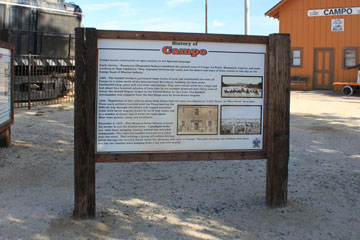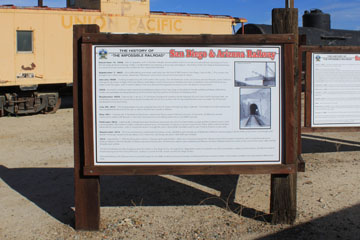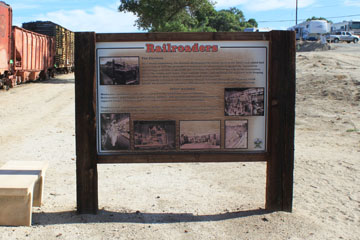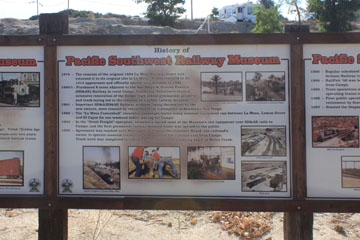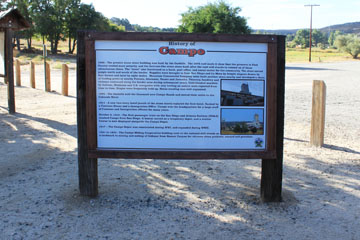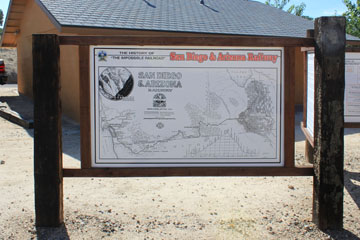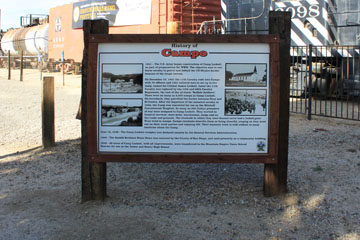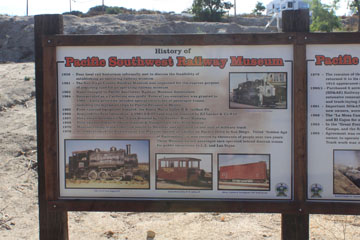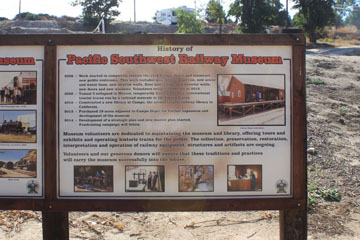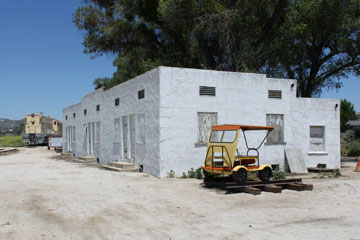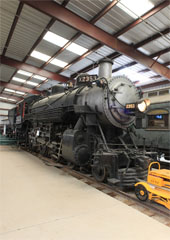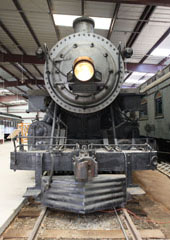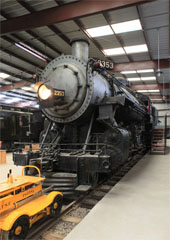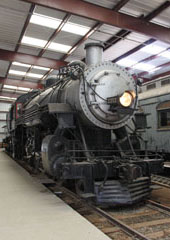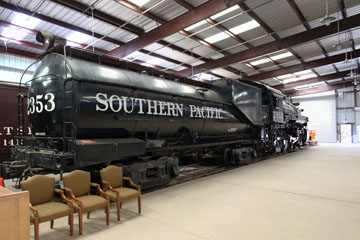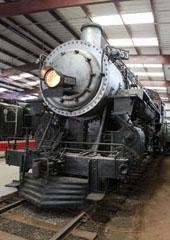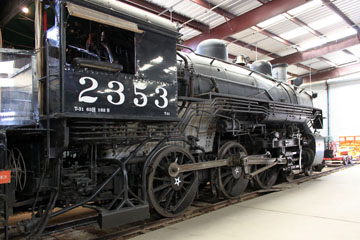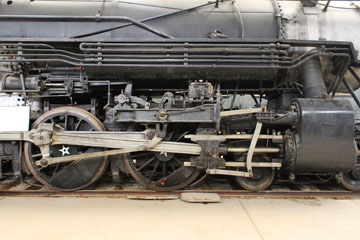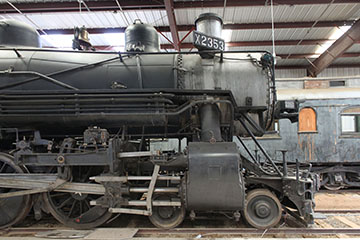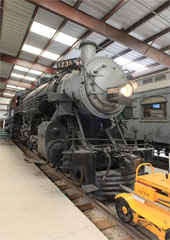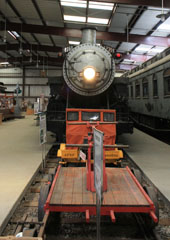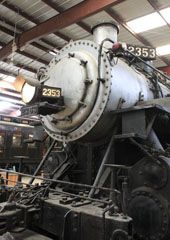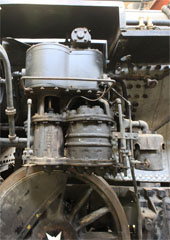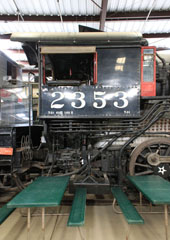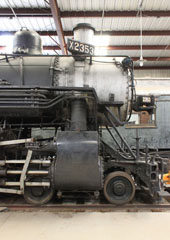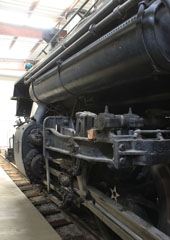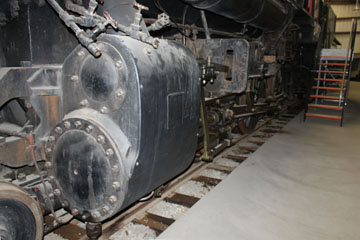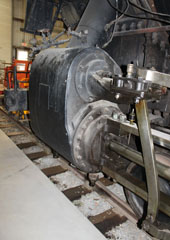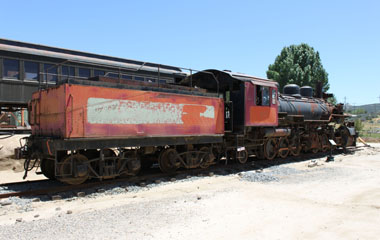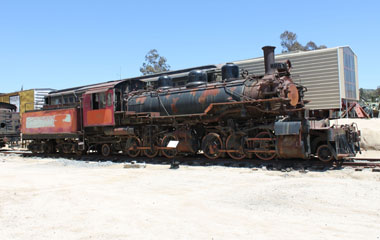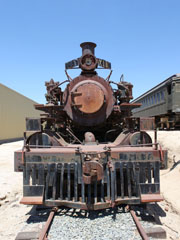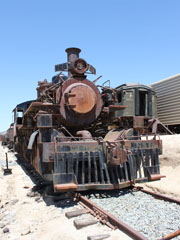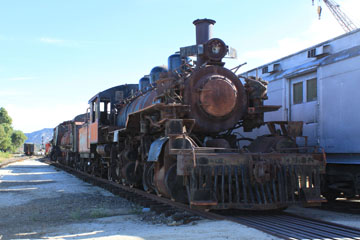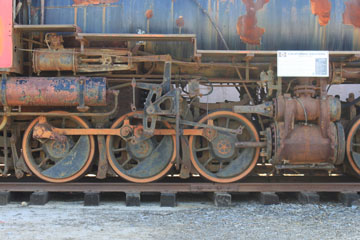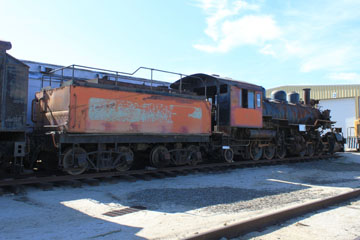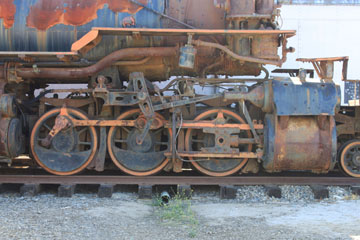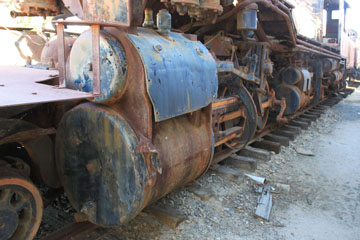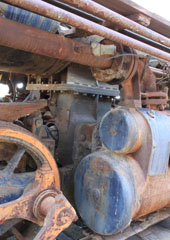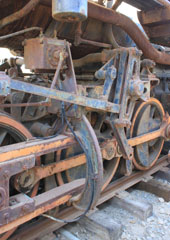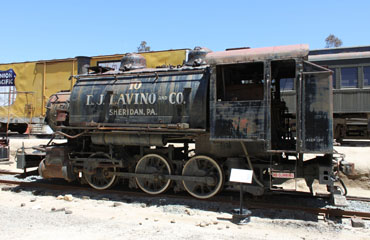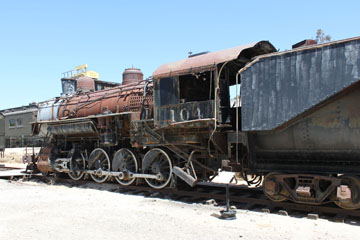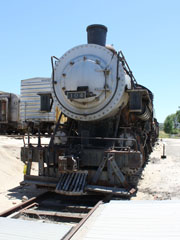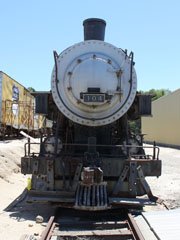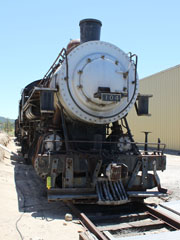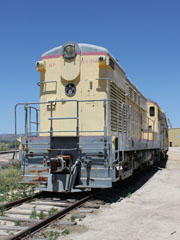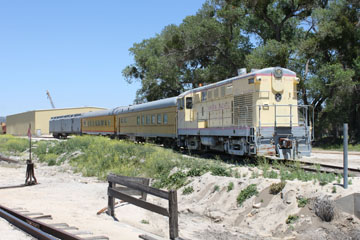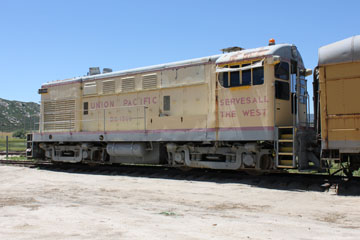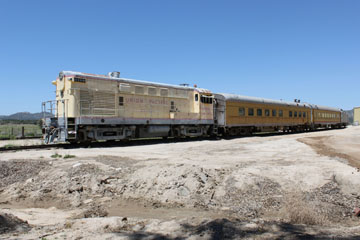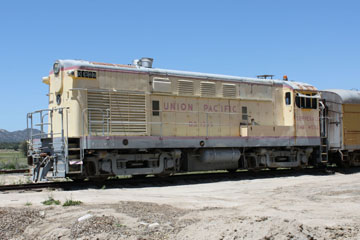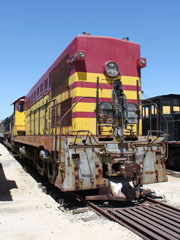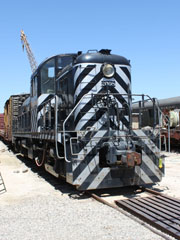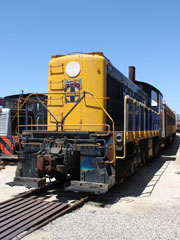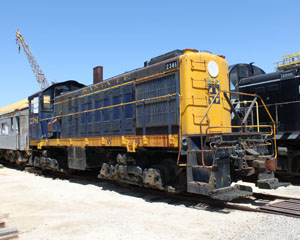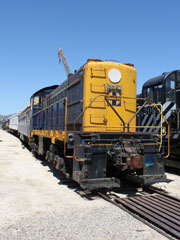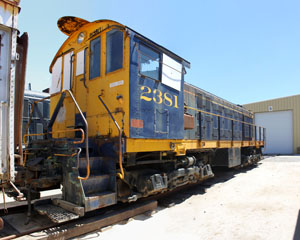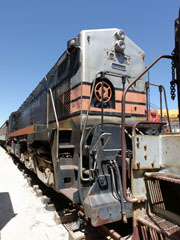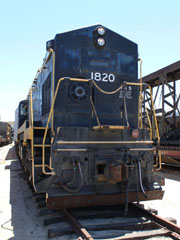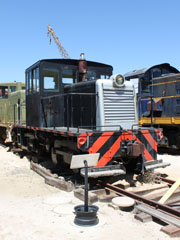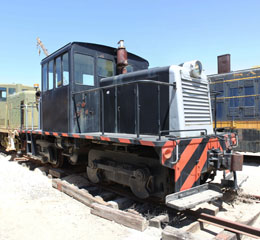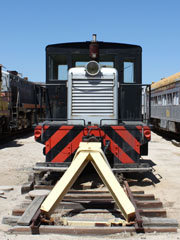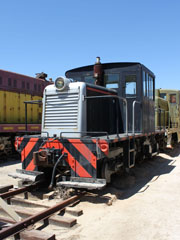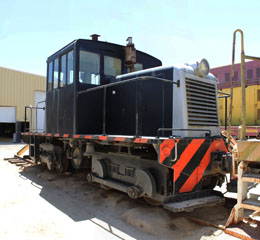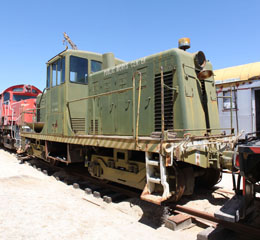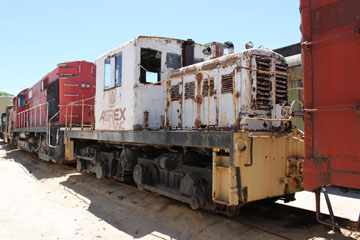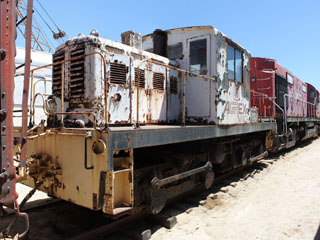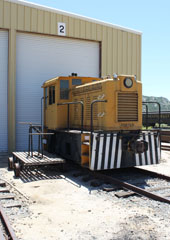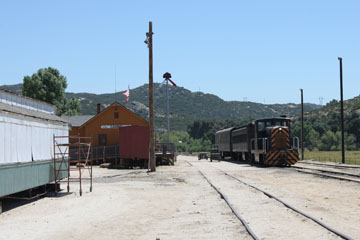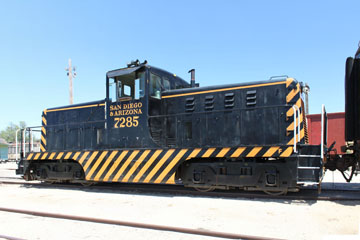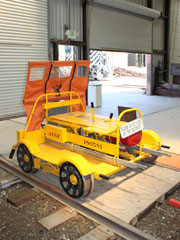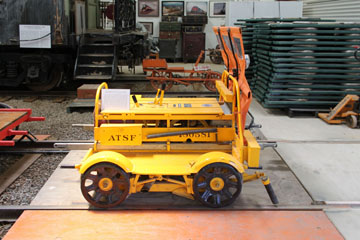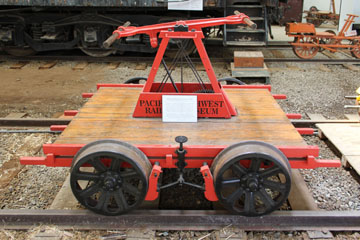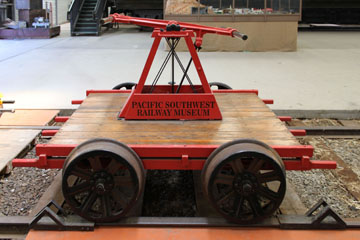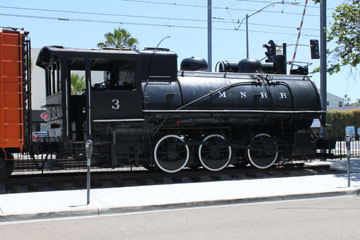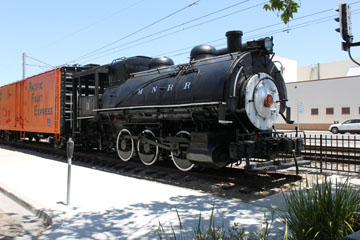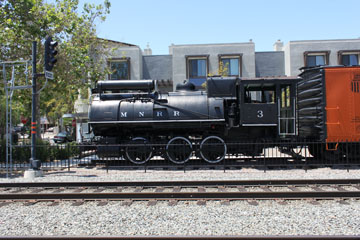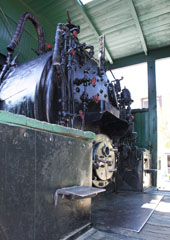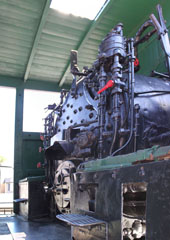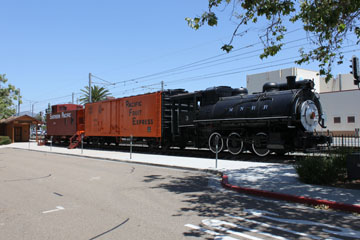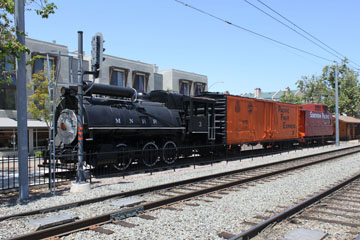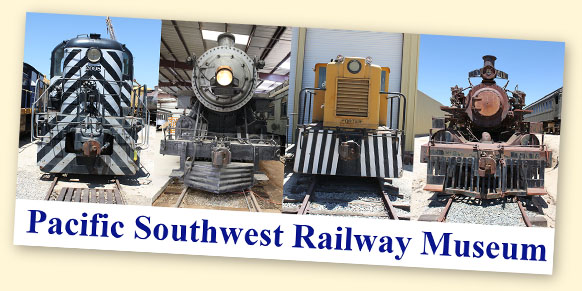

The Pacific Southwest Railway Museum Association is a non-profit organisation dedicated to preserving and interpreting historic railroads in the Pacific Southwest. Its collection is located in Campo, CA, on Depot St, and is open to the public 9.00 am - 5.00 pm Saturday & Sunday except 26th & 27th December and 2nd & 3rd January. The museum also runs passenger excursions using vintage equipment from its collection on many weekends over portions of what was originally the San Diego & Arizona Railway.
European ranchers moved into the Campo area in the late 1860s and a small settlement was soon established with a general store, hotel and school. The San Diego & Arizona Railway reached Campo from San Diego in 1916 by a roundabout route, including 44 miles through Mexico, with the first passenger train arriving on 19th September. In 1919, after financial delays, thirteen years of labour and $17,000,000 in cost (nearly $115,000 per mile) a connection with the Southern Pacific at El Centro was completed to form a direct 148 mile link from San Diego to a transcontinental railroad.
The SD&A was financed partly by developer and entrepreneur John D. Spreckels, and partly by the Southern Pacific. In 1932, financial problems forced Spreckels’ heirs to transfer their share of the railroad to the SP, which then renamed it the San Diego & Arizona Eastern. San Diego’s Metropolitan Transit Development Board bought the SD&AE in 1979 to create an inter-county light rail passenger line. It contracted freight services to a series of private operators, and freight runs continued until a brush fire burned two trestles on 18th June 1983. Coupled with reduced freight traffic, this led to termination of trains through Campo to El Centro.


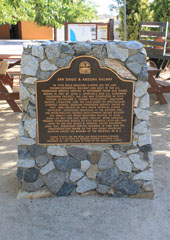
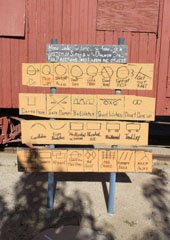
Above, looking north towards the ticket office located in the old Campo railroad depot building. The museum is about 50 miles or an hour and a quarter drive from downtown San Diego. Museum excursions all depart from the depot. The display shed and open air exhibits are a short walk to the north of the depot building.
Below, a view looking south towards the depot building. It is five miles south from here through Campo Valley to International Tunnel #4, which straddles the US/Mexican border, and sixty-six miles to San Diego.
Top left, a plaque provided by the Squibob Chapter of E Clampus Vitus in 1991 commemorates 75 years of rail service. Top right, a set of boards display symbols used to direct and warn hobos on their travels.
The San Diego, Cuyamaca & Eastern was formed to connect San Diego over Warner's Pass to other roads from the east. Completed in 1889, it connected through El Cajon to Lakeside and Foster. It was bought by John D. Spreckels in 1912 and became part of the San Diego & Arizona Railway.

#2353 is the first of ten T-31 Class Ten Wheeler type (4-6-0) locomotives (#2353-#2362) built by the Baldwin Locomotive Works in 1912 for the Southern Pacific.
#2353 started work on San Joaquin/Fresno-Los Angeles Express trains. It was leased in 1927 to
the San Diego & Arizona, which became the SP owned San Diego & Arizona Eastern in 1932. It hauled passenger trains on the San Diego-Campo-El Centro mainline, as well as racetrack specials from San Diego to Agua Caliente in Tijuana, Mexico.
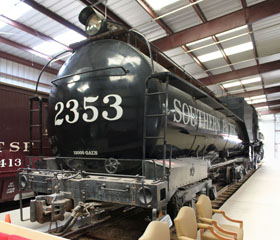

After returning to the Southern Pacific in 1939, the locomotive moved to the San Francisco area to work in freight service. It then served as a switcher at the Bayshore Yards in Brisbane, CA, in the 1950s, as well as hauling San Mateo-Watsonville, CA, gravel trains and switching at a San Mateo lumber mill.
#2353’s last use in 1956 was as helper on Coyote Wells-Hipass westbound SD&AE freights.
#2353 retired in January 1957 and, the following month, was moved using compressed air into the California Mid-Winter Fairgrounds in Imperial, CA, where it remained on static display for the next twenty-nine years.
In 1984 the fair operator donated the locomotive to the museum. After a ten year restoration effort, #2353 steamed again on the old SD&A, running until 2000 when close examination revealed the cost of repairs required to keep it in operation was too prohibitive. It has been in storage in the display shed ever since.
#2353 weighs 208,000 lbs, 162,000 lbs on its 63” drivers. An oil burner with a 32 sq ft grate and 230 sq ft firebox, total heating surface of 2,894
sq ft included 467 sq ft superheating. With
22" x 28" cylinders and Walschaert valve gear, it operated at a boiler pressure of 200 psi
delivering 36,570 lbs tractive effort. This was
later raised to 210 psi, increasing tractive effort
to 38,400 lbs.
The 120-C-1 tender was mated to #2353 in 1921. It has a 12,000 gallon water and 4,000 gallon oil capacity.


#46 was built with saddle tanks for Weyerhaeuser Lumber as #110 and operated out of Camp McDonald, WA, in the Longview area (you can see a Baldwin mallet with saddle tanks on the Black Hills Central page of this website).
In 1954, #110 was bought by the logging company Rayonier, Inc. Renumbered #111, it worked on the ex-Polson Logging Grays Harbor County, WA, lines and then as a standby on the New London-Railroad Camp-Crane Creek mainline until 1967. At some time, it was mated to a slope back tender from Polson Logging #18.
This compound articulated 2-6-6-2 was built by Baldwin in 1937, the second to last logging mallet outshopped by the company.
Baldwin built different types of logging mallets, with tanks or tenders, wood, coal or oil burning (although wood and coal burners were rare, as they created sparks that could ignite forest fires). Relatively small, most weighed between 200,000 lbs and 300,00 lbs and all were fitted with Walschaert valve gear. Their running gear was designed to be particularly flexible to handle the sharp curves and undulating track characteristic of logging railways.
In 1968, #111 was bought by the California Western for the Fort Bragg-Willits Super Skunk tourist trains. Its tanks and fuel bunker were removed and the current tender added.
It worked until 1981 when steam on the CW ceased, and was then donated to the museum.
#46 weighs 247,000 lbs, 210,000 lbs on its 44” drivers. It is 46’ 3½” long, with a total wheelbase of 37’ 11”.
Each of the two driver wheelbases is 8’ long.
The grate is 26.2 sq ft and the firebox 128 sq ft. Total heating surface is 2,012 sq ft including 358 sq ft superheating.
An oil burner with
18” x 24” high pressure and 28” x 24” low pressure cylinders, it operated at 200 psi delivering 30,000 lbs tractive effort (originally 42,517 lbs).
The 50,000 lb tender has a capacity of 2,500 gallons of water and 1,200 gallons of oil.
Top left view, rear drivers, valve gear and high pressure cylinder. Middle left view, front drivers, valve gear and low pressure cylinders. Both cylinders can be seen in the bottom left view.
Top view below, the bolster underneath the front of the boiler. Although connected to the boiler, it does not support any weight on the front engine frame. As the locomotive takes curves, the bolster slides over the plate fixed to the front frame allowing the front frame to pivot. Bottom left, the rear high pressure cylinder is rigidly fixed to the boiler.


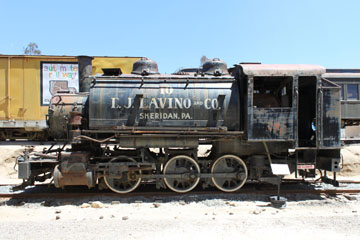
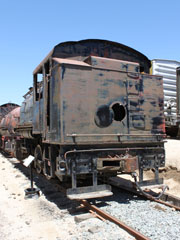
After a request by the museum, #10 was donated to the PSRMA in 1966 and was moved to rented tracks at the Orange Empire Trolley Museum, later the Orange Empire Railway Museum. In 1981 it went on display at La Mesa and then, in 1983, was moved to Campo. It is 32’ 3½” long and weighs 117,440 lbs empty. With 44” drivers, Stephenson valve gear
and 17” x 24” cylinders, it operated at a boiler pressure of 180 psi delivering 24,200 lbs tractive effort.
You can see another E. J. Lavino engine on the Steamtown page of this website.
Alco built this 0-6-0T (Tank) locomotive in 1923 as #10 for the Lavino Furnace Co., later E. J. Lavino & Co. It spent its entire operational life switching at
the company’s ore processing plant in Sheridan, PA, on the Reading Railway’s Harrisburg-Reading mainline.
During the 1960s, #10 was fondly remembered by rail fans for exchanging whistles with steam locomotives hauling the Reading’s “Iron Horse Rambles” through Sheridan (you can see one of the “Iron Horse Rambles” locomotives, RDG T-1 #2124, on the Steamtown page of this website).

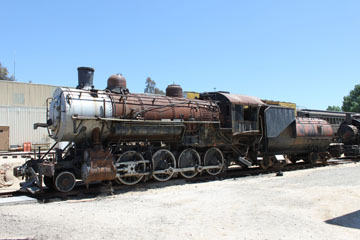
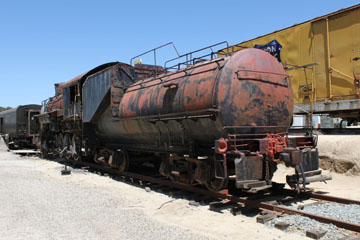
Built for the Southern Pacific by Baldwin in 1904 for $17,969.01 and numbered #2720, this Consolidation (2-8-0) type locomotive was bought by the San Diego & Arizona in 1921 for $37,000 and renumbered #104. It was used on freight as well as passenger runs, and appeared in the 1923 promotional film, Carriso Gorge, The Magnificent and, in 1926, the MGM movie Red Lights with Marie Prevost and Jean Hersholt.
#104 was requisitioned on long-term lease by the SP in 1941, and returned to its original SP #2720 number.
#2720 worked across the SP system until 1948, when it returned to the SD&AE and was renumbered #104. Leased back to the SP in 1950, it worked as #104 at the SP’s Bayshore yards in Brisbane, CA, until retired in 1954.
In 1955, the SP donated #104 along with ex-SD&AE Carriso Gorge Business Car #050 to the Southern California Exposition/San Diego County Fair in Del Mar, CA, where it went on display for the next twenty-seven years. In 1982, the fair operator donated it to the museum, and it arrived in Campo in August 1983.
#2720 originally had a square tender, which was replaced in 1940 by a Vanderbilt tender.
Some time between 1951 and 1955, it was then mated to the current Vanderbilt 90-C-6 tender weighing 57,600 lbs light with a capacity for 9,000 gallons of water and 3,535 of oil.
#104 is 38’ 5 3/16” long with a driver wheelbase of 15’ 8” and engine wheelbase of 24’ 4”.
As built, the engine weighed 206,800 lbs, 183,100 lbs on its 57” drivers. In 1918, the SP added superheating, increasing the weight to 216,700 lbs, 191,100 lbs on its drivers.
With the addition of the superheater, the boiler pressure was raised from 200 psi to 210 psi, and the rebuild produced a 5% increase in tractive effort from 43,300 lbs to 45,470 lbs.
The engine is equipped with Stephenson valve gear and 22” x 30” cylinders.

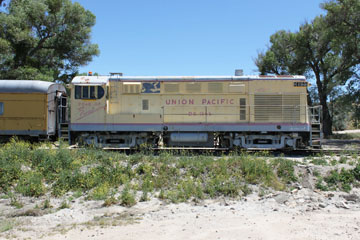

This unit was built by Fairbanks Morse as demonstrator #2000 in 1947 and was then sold to the Union Pacific where it was renumbered #1366. It was bought by Southwest Portland Cement and renumbered #66 in 1962, and then #408 in 1969. SWPC donated the unit to the museum in 1985, where it has been restored to its original UP number and livery.
Only three H-20-44s have survived. You can see SWPX #409 (ex-UP #1360), on the Illinois Railway Museum Yard page of this website and SWCP #401 on the Galveston Railroad Museum page.
The H-20-44 was a heavier duty version of the 1,000 hp H-10-44 (you can see the first
H-10-44 production model, MILW #760, on the Illinois Railway Museum Yard page of this website).
The Union Pacific bought eleven H-20-44s (#1360-#1370).
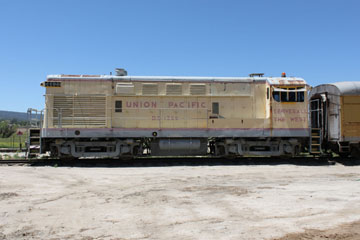

Weighing 240,000 lbs and 51’ long, #1366 has a
2-cycle 38D8 1/8 (6 cylinder OP) prime mover powering a Westinghouse WE474A generator to drive four Westinghouse WE37DE traction motors. Delivering 55,000 lbs continuous tractive effort at 12.9 mph, it had a top speed of 60 mph.
Few railroads saw sufficient value in moving freight in greater quantities or at higher speeds than was possible with the typical 1,500 and 1,600 hp four-axle road switchers already available, only ninety-six H-20-44s were produced from June 1947 to March 1954, all for US railroads.

Baldwin built two hundred and fourteen 1,600 hp AS-616 road switchers and seven cabless B units from 1950 to 1954.
#1 was built as demonstrator #1601 and displayed at the 1953 Association of American Railroads convention in Atlantic City, NJ.
#1610 was the first of the second series AS-616 units, with roller bearings, different trucks and higher hoods that came within two inches of the cab roof.
Relettered BLH #1601 after the convention, it was tested by railroads in Wisconsin, Minnesota and Michigan.
#1601 returned to Baldwin’s Eddystone plant for storage in the autumn of 1953.
Normally costing $145,000, it was sold a year later at a discount price of $90,000 to the fifty-one mile logging railroad, the Oregon & Northwestern in the Silvies River area.
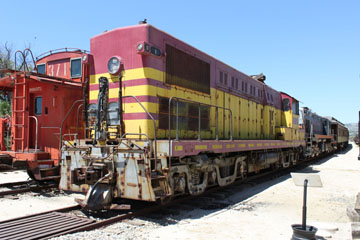
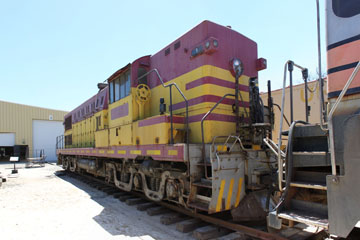
Renumbered #1, the unit started service on the Oregon & Northwestern in January 1955. After thirty years service, It was placed in storage when the ONW ceased operations in 1985 and was bought by the museum in 1990.
#1 has a 4-cycle Model 608 SC prime mover and Westinghouse WE471 generator powering six Westinghouse WE370 traction motors, one on each axle. Weighing 237,800 lbs and 58’ long, it delivered starting tractive effort of 97,500 lbs at 30% and 78,750 continuous tractive effort at 6 mph with a top speed of 60 mph.

The Kennecott Copper Corp., bought this Alco RS-2 in 1949. It hauled ore cars on the nineteen mile line between the company’s open pit copper mine at Ruth, NV, and the smelter at McGill until 1983.
It then worked briefly at the Bingham Canyon, UT, open pit as #907.
Three hundred and eighty-four of these road switchers were built between 1946 and 1950, including nine by Alco’s subsidiary, the Montreal Locomotive Works, in Canada.
Thirteen of the units were exported overseas. The remainder went to US railroads.
Kennecott donated #103 to the museum in 1984 (you can see another KCCX RS-2, #105, on the Nevada Northern Railway Museum page of this website).
#103 was repainted as ATSF #2098 in 1988 for Railfair ’88 at the Santa Fe’s Wright Street yard in San Diego, CA.


The 1,500 hp RS-2 was a step up from Alco’s first road switcher, the 1,000 hp RS-1, and was designed to compete with the growing number of similarly powered offerings from EMD, Fairbanks Morse and Baldwin. Alco’s race for power produced the 1,600 hp RS-3 in 1950 and culminated in the 2,400 hp RS-27 in 1963, its most powerful road switcher.
With a 4-cycle Model 244 V12 prime mover and GE GT581 generator powering four GE 752 traction motors, one on
each axle, the RS-2 delivered 57,800 lbs starting tractive
effort at 25% and 42,500 lbs continuous tractive effort at 10 mph. It is 55’ 5” long, weighs 230,000 lbs and had a top speed of 65 mph.

This is one of ten 2,000 hp RS-32 units bought by the Southern Pacific from Alco in 1962
(#7300-#7399). In 1965, they were renumbered #4000-#4009, #7304 becoming #4004 (you can see another of the ten, #7302 still operating as Delaware-Lackawanna #211, on the Steamtown Yard page of this website).
Only thirty-five RS-32s were built from 1961 to 1962, the other twenty-five for the New York Central (#8020-#8044), and they were amongst the last diesels built by Alco. All ten SP RS-32s were sold in 1978-79.
Chrome Crankshaft bought most and leased them to various operators retaining their SP numbers. #4004 went to San Diego’s SD&AE to work freight over the San Diego Trolley line to El Cajon. In 1981, it was sold to the J. R. Simplot Co., in Pocatello, ID, where it worked until 1989 and was then donated to the museum.
#7034 is 57’ 2” long and weighs 240,000 lbs. A 4 cylinder 251C V12 prime mover powered a GE GT581D2 generator to drive four GE 752 traction motors. With a top speed of 80 mph, it delivered 35,000 lbs continuous tractive effort at 8 mph.

#2381 was one of the last batch of S-2s bought by the Santa Fe in 1949 (#2379-#2391).
All of the S-2s were assigned to the AT&SF’s Western sections, including yards in Los Angeles, San Diego, San Bernardino, Barstow, Bakersfield, Fresno and Richmond.
Alco built one thousand, three hundred and sixty-three S-2s from 1940 to 1950 for US railroads and twenty-three for Mexican. Alco’s Canadian subsidiary, MLW, built another one hundred and thirteen for Canadian railroads.
The AT&SF owned seventy (#2322-#2391).
The S-2 weighs 229,700 lbs and has an Alco 539 turbocharged 6L prime mover and GE GT553 generator powering four GE 731 traction motors, one on each axle. With a top speed of 60 mph, it developed starting tractive effort of 69,000 at 30% and 34,000 lbs continuous at 8 mph.
The S-2 is almost identical to Alco’s S-4, except it has Alco's Blunt trucks while the S-4 has AAR type A switcher trucks. The S-4 also has a GT 563 generator and GE 731D traction motors.
#2381 spent many years in San Diego, including working the transfer haul from the San Diego yard to National City.
#2381 was retired in
1977 and placed in storage. It was later donated to the California State Railroad Museum which, in turn, donated it the PSRMA.

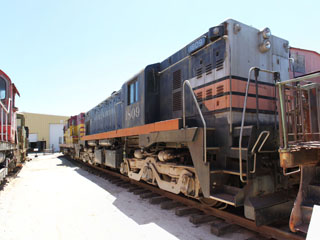
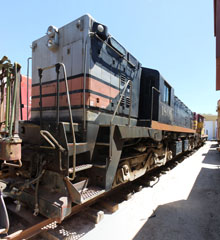
Thirteen MRS-1s were built by Alco and EMD to the same specification for the US Army in 1952. After testing, seventy more were ordered between 1953 and 1954.
An EMD MRS-1 is shown next on this page. There are more MRS-1s on the Nevada Northern page of this website.
#1809 was built by Alco in 1952 as USAF B-1809 and sent to Marietta Air Force Station, Marietta, PA. It then moved about from Alaska to Utah and California on different assignments before being sent in 1979 to the National Transportation Group, Rail Service Division storage yard at Hill Air Force Base near Clearfield, UT, for disposal.
In early 1982, #1809 was donated to the PSRMA after being released as surplus by the National Air Force Rail Item Manager. It has been restored to the “black widow” scheme of the first SP diesels used on the SD&AE in the 1950s.

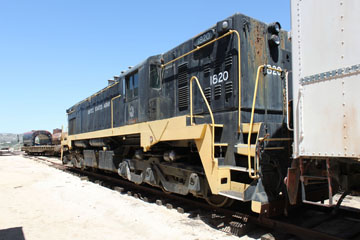

#1820 was built by EMD in 1952.
It has a 567B 16 cylinder prime mover powering a GM D22 generator to drive six GM D27 traction motors. It delivered starting tractive effort of 90,800 lbs at 25% and 95,000 lbs continuous tractive effort with a top speed of 83 mph.
The MRS-1 was designed with the prospect of another land war in Europe during the “hottest” years of the Cold War, so it was equipped with adjustable trucks to fit different railroad gauges, compact bodywork to accommodate restrictive rights of way and replaceable couplers. The land war never eventuated, however, and most went to military installations around the country.
#1820 spent most of its life at Forty Eustis, VA. It moved to the storage yard at Hill Air Force Base near Clearfield, UT, in 1971 for disposal and was bought by the PSRMA in 1982 with USAF B-1809.

#7485 weighs 90,000 lbs and is 28’ 4” long.
It is powered by two Cummins HB1-600 diesel engines each developing 150 hp. Each engine drives a GT1503 generator, which then powers one GE 733 traction motor on each truck, with side rods connecting the axles.
This GE 45 ton switcher was delivered to the
Plum Brook Ordnance Plant near Sandusky,
OH, in 1941 and went on to work at various US Army and Air Force facilities in California and Utah.
It then went into storage at Hill Air Force Base near Clearfield, UT.
#7485 was transferred
to the US Navy and donated to the museum in 1973.
You can see other GE 45-Ton switchers on the Mid-Continent Railway Museum page of this website, the Orange Empire Railway Museum and the Illinois Railway Museum Yard pages.

It is powered by two Caterpillar D17000 V8 diesel engines totalling 380 hp, with two GT555Al generators powering four GE733 traction motors, one on each axle.
You can see other 44 ton switchers on the Pueblo Railway Museum page of this website, the Savannah Roundhouse Museum, National Railroad Museum, Southeastern Railroad Museum and Kentucky Railway Museum pages.
Built by GE in 1941, this 44 Ton switcher is 33’ 5” long and weighs 88,000 lbs. Bought by the US Government for $65,000, it was sent to the Iowa Ordnance Plant at Dayman, IA, as #10-44. After the end of the war, it moved to various facilities before two cracked
cylinder heads rendered it inactive in 1985.
Declared surplus, USN #65-00608 was donated to the PSRMA in 1989.

After AGREX went out of business, the switcher was abandoned and then
acquired by the Port of Long Beach, CA. It was donated to the PSRMA by the Port in 1988.
Power is provided by two Cummins HBI 600 diesel engines developing 150 hp each at 1,800 rpm. With Westinghouse traction motors on two of its four axles, siderods connect the powered axles to the unmotored ones. Weighing 90,000 lbs and 26’ 10” long, it has a top speed of about 20½ mph.
Built for the US Navy by Whitcomb in 1945, this switcher was delivered to the Naval Ammunition Depot, Seal Beach, CA. Its initial service number is unknown but, in 1949, it was assigned
#65-00316 while still at Seal Beach.
After eighteen years in Navy service, in 1963, #65-00316 was sold to a used locomotive dealer and stored at the former Pacific Electric Railway 8th Street yard in Los Angeles for four years. In early 1967, it was sold to Koppel Bulk Terminals, a grain bulk-loading firm in Long Beach, CA. Koppel was later taken over by AGREX.

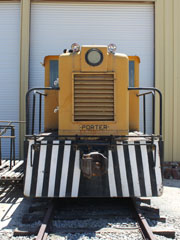
A 25-ton diesel-electric built by H. K. Porter in Pittsburgh, PA, this little switcher was probably one of six built for stock in 1947-48. It was sold to the National Supply Company in Torrance, CA, and numbered #1. When NSC became a division of ARMCO, it was renumbered #1528.
By 1983, #1528 was surplus and was sold to Robert W. Babcock of Orange, CA, who then leased it to the Mitchell Company, which had contracted to rebuild storm damaged trackage in northern San Diego County on the Marine Corps Base at Camp Pendleton, CA, and the Naval Weapons Station Annex at Fallbrook.
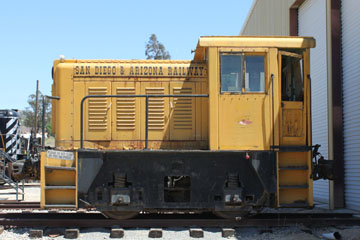

Babcock renumbered the switcher #8157X, which was its builder’s number. In 1985, he leased it to
the PSRMA for $1.00 a year, where it was
repainted as San Diego & Arizona Railway #8157, although it never actually worked on the SD&A. Babcock donated #8157 to the museum in December 1988.
#1 weighs 50,000 lbs. It is equipped with a Cummins HBI 600 150 hp diesel engine and Westinghouse 189R7 300-volt generator which powers a Westinghouse 14434 traction motor on its rear axle connected by a chain drive to the non-motored front axle.

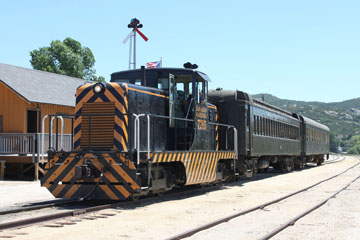
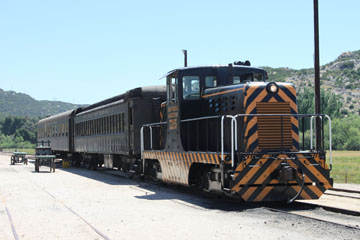
This ex-US Army 80 ton switcher, repainted in a Southern Pacific “Tiger Stripe” livery and designated SDA #7285, was hauling the museum’s Valley Flyer on the day I visited.
Built by GE in 1943, it has two 250 hp Cummins LI600 diesel engines, two GT549 generators and a GHM1133 traction motor on each axle. First assigned to the New River Ordnance Plant in Radford, VA, and then the Volunteer Army Ammunition Depot in Chattanooga,TN, in 1946, it transferred to the US Marine Corps at Camp Pendleton, CA, in 1965, renumbered #248391.

#248391 was rebuilt by the Chattahoochee Locomotive Co., in Cornelia, GA, under the Service Life Extension Program in 1986 with two 335 hp Cummins NTA-855-L4 diesels.
Based at Camp Pendleton, VA, in January 1993, a flash flood covered the engine’s traction motors and, although cleaned up, they were not repaired and #248391 was declared surplus. It was donated to the museum in 1993.
Repaired by PSRMA members at the San Diego & Imperial Valley Railroad shops in San Ysidro, CA, it arrived at Campo in 1995.

Fairmont Railway Motors Inc, in Fairmont, MI, built motor car #180581 in 1940 for the AT&SF.
These cars were used by track inspectors and railroad work crews to move
quickly to and from work sites with their tools
They could be lifted clear of the tracks to allow regular trains to pass (note the handles at the rear of the car). Other uses included signal and telegraph maintenance and fire prevention.
Fairmont Railway Motors was founded in 1909, and built many motor cars like this one. The first were fitted with single cylinder diesel engines, the distinctive sound they made earning them the nickname “Pop Cars”. Later models had four cylinder Ford Model A and Model T engines, but were superseded in the 1940s by “Hi Rail” trucks, also developed by Fairmont.
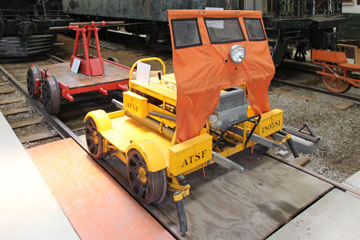
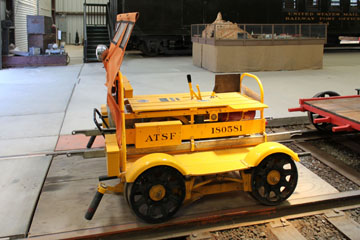
Parked beside #180581, this hand car was built c.1898 by the Kalamazoo Railroad Velocipede & Car Co., in Kalamazoo, MI.
The company was founded in 1883 by George Miller and Horace Haines, with a factory in downtown Kalamazoo. By 1901, it had changed its name to the Kalamazoo Railway Supply Co. It manufactured hand and push cars, motor cars, velocipedes, jacks, tanks, stand pipes and other products needed for railroad work. In the 1940s, it diversified into small materials handling trucks, and finally went out of business in 1994.
With the advent of gasoline powered engines, few hand cars like this were built after about 1912, but a surprising number have survived. You can see other examples on the Orange Empire Railway Museum page of this website and the Crewe Railroad Museum page. Another interesting MOW vehicle is shown on the Nevada State Railroad Museum: a two person built by the Light Inspection Car Company of Hagerstown, IN.
You can also see other Fairmont equipment on the Monticello Railway Museum page and the Crewe Railroad Museum page.


Also part of the museum’s collection, but on display in La Mesa, CA, about fifty miles west of Campo, Mojave Northern #3 sits beside the San Diego Trolley line, once part of the San Diego & Arizona Railroad right of way.
#3, an 0-6-0T (Tank) locomotive was built by the Davenport Locomotive Works in Davenport, IA, in 1923.
It weighs 118,000 lbs, has 42” drivers,
17” x 24” cylinders and operated at a boiler pressure of 180 psi delivering 15,275 lbs tractive effort. An 800 gallon oil tank and a 2,000 gallon water tank “saddle” the boiler.
The Mojave Northern Railroad was built in 1915-16 by the Southwestern Portland Cement Co., from its plant at Leon in northern Victorville, CA, 5½ miles to Sidewinder valley in the Mojave desert. It was extended five miles to Bell in 1947 and seven more to Reserve Quarry in 1951.
#3 worked mainly in the Leon cement plant until steam operations were replaced by diesels in 1957. It was donated to the PSRMA in 1966, and went on display at La Mesa in 1981. You can see another MN 0-6-0T, #2, on the Orange Empire Railway Museum page of this website.
#3 is on display with Pacific Fruit Express R-S Reefer #11207 and Southern Pacific C-40-3 Caboose #105.
#11207 was built by the PFE in Colton, CA, in 1957. The “R-S” signifies ice or ice & salt cooled the cargo space (ice blocks were dropped through rooftop hatches at icing stations en route). It was bought by PSRMA in 1986. #1058 was built by the SP in Los Angeles, CA, in 1941. It was retired and stored at SP’s yard in Tracy, CA, ready to be scrapped. In 1984 it was bought for display at the La Mesa Depot by the PSRMA.




